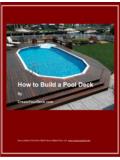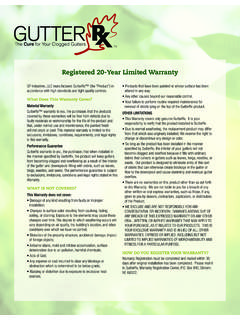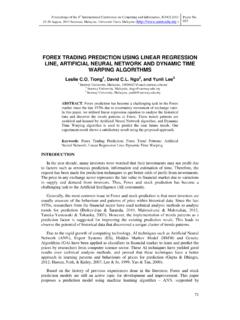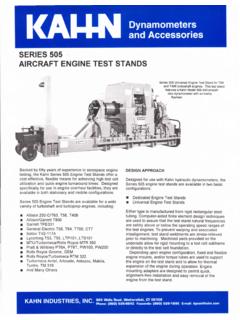Transcription of Ultra-Large Container Ships (ULCS) - AntiPort
1 Neither Lloyd's Register nor any of its officers, employees or agents shall be responsible or liable in negligence or otherwise howsoever inrespect of any inaccuracy or omission derogating from the generality of the foregoing neither Lloyd's Register nor any of its officers, employees or agents shall beliable for any indirect or consequential loss caused by or arising from any information advice or inaccuracy or omission herein. Lloyd's Register of Shipping Container Ships ( ulcs )designing to the limit of current and projectedterminal infrastructure capabilitiesDavid TozerAndrew PenfoldLloyd s Register of ShippingOcean Shipping Consultants LtdAbstractThe Container shipping market is increasing at about 8%per annum and this is expected to continue for at leastthe next decade.
2 Studies indicate that ultra -largecontainer ship ( ulcs ) designs are not only feasible butmay be a necessary development if this marketexpansion is to be accommodated in the most costeffective and anticipated capabilities of containerterminals, together with possible improvements inshoreside facilities and ship operational design, arereviewed. Likely developments in this expanding sectorof the Container shipping market are identified. Thestudy ascertains the optimum capacity of a ulcs , based oninfrastructure and market considerations, to be12,500 TEU, a ship of about VLCC on the study, possible design configurations andstructural arrangements have been examined to establishthe design challenges associated with these large IntroductionLloyd s Register has, since the introduction of the firstISO standard Container in the early 1960s, been involvedwith the development and the design appraisal ofdedicated cellular Container latest post-panamax Ships have a capacity of nearly8, have been many studies reported widely in thepress examining future prospects for even larger of these are considered to be highly speculative.
3 Others are designed for specific routes and ports - somehave been funded by particular s Register therefore decided to commission anindependent investigation into the prospects for Ships ofthis type and size in order to identify potential designchallenges, particularly from the Classification ulcs study by Lloyd s Register, with OceanShipping Consultants (OSC), commenced in the summerof 1999 and the first results were published inMarch 2000 [1] and July 2000 [2]. The results of ourfurther study were presented at Boxship 2001 inLondon [5].The content of this paper is fundamentally in three parts, evolution of Container Ships , the design challengesassociated with ulcs vessels and the market Evolution of Container ShipsIn the past 40 years Container Ships have evolved fromsmall feeders, through panamax to the latest post-panamax Panamax Ships still represent the lion s shareof the world Container ship fleet, the largest post-Panamax Ships in service today, with capacitiesapproaching 8,000 TEU, now represent some of theworld fleet of Container Ships , 22% by total the current order book is included these figuresincrease to (by number of Ships ) and 24% (by totalseagoing capacity).
4 0%10%20%30%40%50%60%70%80%90%100%includi ng ordersin service now2000199919981997199619951994199319921 9911990 YEAR OF BUILDPOST-PANAMAXPANAMAXUNDER-PANAMAXF igure 1 Evolution of Container ship fleetFigure 1 illustrates the manner in which the containership fleet has evolved during the past 10 years. It isapparent that the 40% market share held by under-panamax Ships has been steady over this , the panamax fleet is declining, in percentageterms, as the post-panamax fleet grows in future is clearly looking good for post-panamaxships. It was for this reason that it was decided toinvestigate the future prospects for these largest Design ChallengesThe OSC study into the present and projectedcapabilities of the terminals, which will be detailed later,determined that the maximum principal dimensions of aULCS will be as follows:Beam,B= 57m (22 boxes abreast on deck)Length,Lpp = 381mDepth,D= 29mDraught,T= 14 5mShip Speed V= 23-25knotsIn order to validate the concept, and to identify thedesign challenges associated with Ships of this type andsize, and in particular to identify any structural issueswhich Lloyd s Register should be considering inanticipation of ulcs design submissions, a number ofconceptual designs were ship Structures!
5 Conceptual Design 1, Wide Skin Option22 stacks on deckunderdeckpassageway18 stacks in hold9 tiers in holdwater ballastspacesFigure 2 - Conceptual Design 1, Wide Skin OptionPrincipal parameters:LxBxD=381x57x29m7 tiers, 22 stacks on deck9 tiers, 18 stacks in this concept, the side structure has been designed toaccommodate two stacks of containers on deck, eachside. The double side and double bottoms are for of the greatest challenges for Container shipdesigners is hull flexibility, particularly from this reason, deck containers which straddle twohatch covers are vulnerable to damage, to the lashingsand even to the containers themselves, as the hatchcovers try to move relative to one Container straddling the side pedestal and the outboardhatch cover is even more this into consideration, the Container stowagearrangements have been hull form was developed in order to carry out anaccurate Container count.
6 It was found that the hull formcould accommodate 12,100 TEU containers.! Conceptual Design 2, Narrow Skin Option22 stacks on deckunderdeckpassageway20 stacks in9 tiers in holdwater ballastspacesFigure 3 - Conceptual Design 2, Narrow Skin OptionA further design concept was developed with a narrowside structure, wide enough to accommodate just onestack of containers on the deck each side. However,structurally it is more onerous and careful considerationwill be required from structural design has a capacity of 12,500 TEU. It was furtherfound that this design could have a capacity of13,000 TEU by moving the deckhouse forward.! Effect of Re-Locating SuperstructureWhen the deckhouse is in the conventional position,above the engine room, the capacity of the wide skinoption is about 12,100 TEU.
7 Capacity on deck is limitedby the IMO visibility criterion which requires that thewater surface 500m forward of the bow must be visiblefrom the bridge. There is no requirement for Against Accommodation Position11,80012,00012,20012,40012,60012 ,80013,00013,200123456789101112131415161 7181920 Position of accommodation (ER remains at hold 20 & 21)TEU capacity12,500 Figure 4 - Effect of Re-locating SuperstructureAs the deckhouse moves forward the Container capacityincreases, as a result of the visibility requirements,Figure 4. By locating the deckhouse at about midships,the required capacity of 12,500 TEU can be achieved forthe wide skin option. This also provides a number ofother benefits such as spare space under accommodation( for fuel) and improved torsional Midship Section Scantlings!
8 Hull Girder BendingThe first design challenge is to provide sufficient hullbending strength. Midship section scantlings have beendeveloped, for the wide skin option, Figure 5. HT36steel has been used throughout, with a frame spacing ofabout 10 feet. The scantling assessment indicates thatthe hatch side coaming needs to be about 65mm thickand other topside structure 60mm; the remainder of thestructure is conventional compared with existing largecontainer 5 Midship Scantlings: Wide Skin OptionFigure 6 Midship Scantlings: Narrow Skin OptionMidship section scantlings have also been developed forthe narrow skin option, Figure has been necessary in this case to introduce anadditional deck in order to achieve the required hullgirder inertia.
9 The coaming is once more 65mm and therest of the topside structure is now also 65mm. Theremainder of the ship is, again, conventional .So, there appear to be no insurmountable difficultieswith this design concept.! Torsional StrengthThe greatest design issue for Container Ships having largehatch openings is torsional strength. A detailed torsionalanalysis has been carried out and the results, Figure 7,indicate that if the deckhouse is located amidships thetorsional response is reduced by about 30%, a rate of twist of the wide skinned concept is of thesame order as that of existing large Container Ships , evenif the deckhouse is located towards the aft ista nce from A P (m )R ate of T w ist (d egree/ m )Deckhouse midshipsDeckhouse aftDeckhouse midshipsDeckhouse aftMax Permissible-120-100-8 0-6 0-4 0-2 0020406080100W arping Stress (N /m m )
10 Wide skin - deck aftwide skin - deck midshipsnarrow skin - deck aftnarrow skin - deck midshipsFigure 7 Torsional ResponseIt has been found that the addition of the midshipsdeckhouse also has a substantial benefit in reducing thewarping warping stresses occur at the ends of the hatchopening region and are the most critical at the engineroom front, where they are combined with other hullgirder load components. If the deckhouse structure islocated amidships, the warping stress is reduced by 20%at the engine room front and is of the order of that ofexisting large Container Propulsion SystemA limited number of propulsion options have beenexamined for the purposes of this study:" Single engine, single screw" Twin engine, twin screw" Contra-rotating propellers" Single engine + twin podded unitsThe aim of this study is to establish the viability of sucha ship design and to identify design challenges , not toproduce an optimum details of our study on propulsion systems are givenin reference [4].







